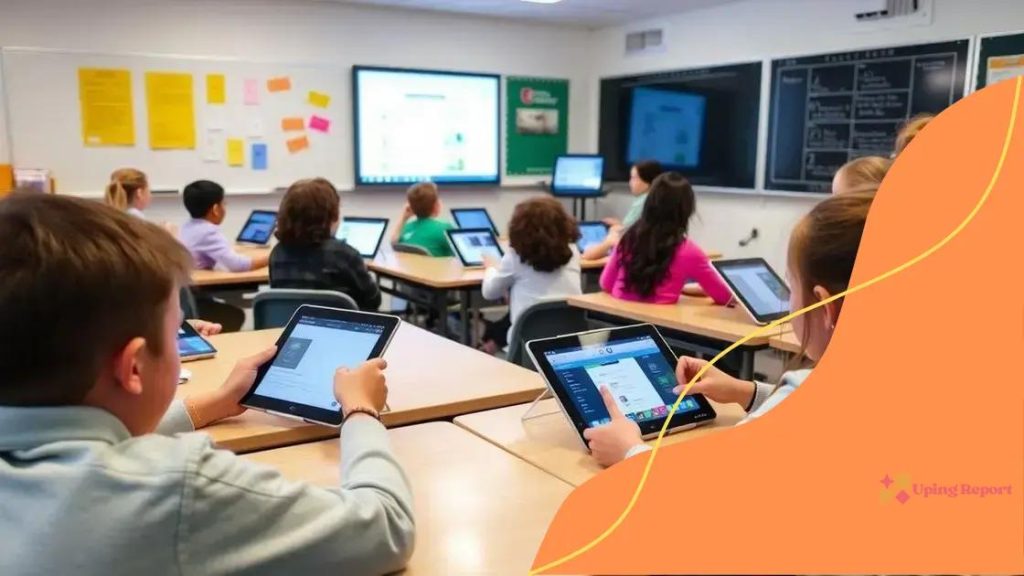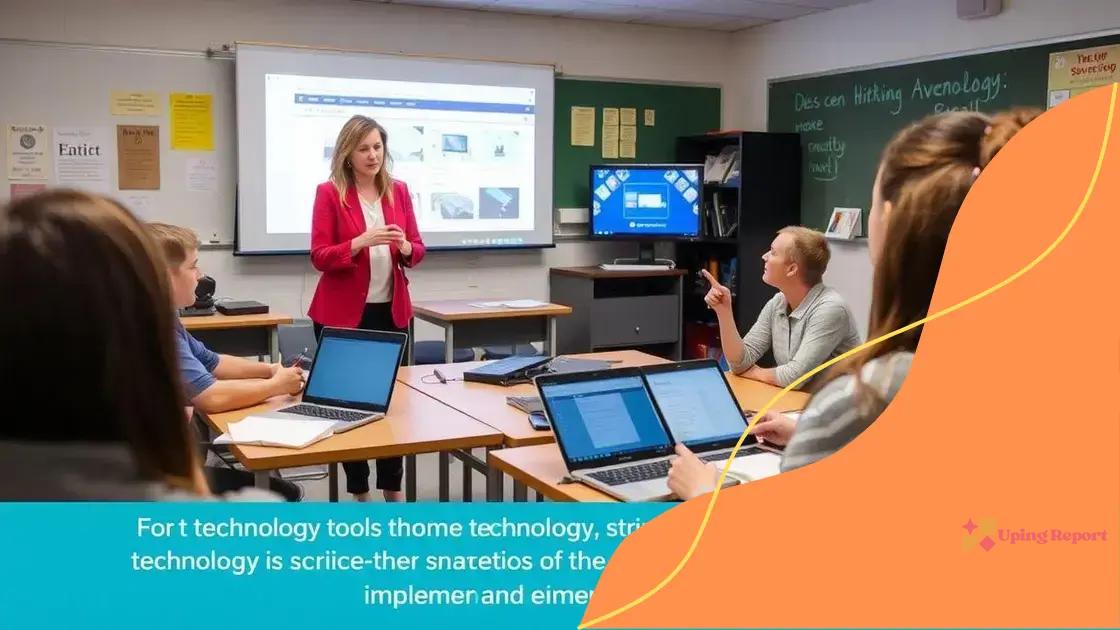Education technology integration: Enhance learning experiences now

Education technology integration enhances learning by utilizing tools like AI and VR, though it faces challenges such as the digital divide and resistance to change among educators.
Education technology integration is reshaping how we approach learning today. Have you ever wondered how technology can make education more engaging and effective? In this article, we’ll explore exciting tools and strategies to enhance learning experiences.
Understanding education technology integration
Understanding education technology integration is crucial in today’s learning environments. As technology becomes an integral part of education, it is essential to comprehend how these tools can reshape the classroom experience.
One of the primary aspects of this integration is recognizing the various types of technology available. Here are some categories:
Types of Education Technologies
- Learning Management Systems (LMS): Platforms that facilitate online learning and course management.
- Interactive Tools: Software and applications that engage students actively during lessons.
- Assessment Tools: Technologies used to evaluate student performance and understanding.
By understanding these categories, educators can select the best tools for their needs. It’s important to consider how these technologies can enhance student learning and engagement. Effective integration means not just using technology, but ensuring it complements teaching methods.
Additionally, it’s vital to address how technology affects classroom dynamics. Students today are digital natives, meaning they grow up with technology, and this shapes their learning preferences. They often prefer interactive and engaging content, which leads to better retention.
Benefits of Integrating Technology
When done correctly, integrating technology brings numerous benefits. Some key advantages include:
- Increased Engagement: Technology grabs students’ attention in ways traditional methods may not.
- Personalized Learning: Tools can tailor lessons to individual students’ needs and learning paces.
- Collaboration: Technology fosters teamwork and communication among students.
However, challenges do arise. Educators must ensure that every student has equal access to technology, avoiding any potential disparities. Furthermore, training and support for teachers are critical to maximize the effectiveness of new tools.
In summary, understanding education technology integration involves knowing the types of technologies available, recognizing their benefits, and addressing the challenges they present. By navigating these aspects, educators can create more inclusive and dynamic learning environments.
Key benefits for students and teachers
One of the most significant aspects of education technology integration is its ability to provide key benefits for both students and teachers. With the right tools, learning becomes more engaging and effective.
For students, technology offers a multitude of advantages. Enhanced accessibility is essential; students can access resources anytime and anywhere, which supports learning beyond the classroom. This flexibility allows them to review materials at their own pace, leading to better mastery of subjects.
Benefits for Students
- Increased Engagement: Interactive tools make learning fun, sparking curiosity and encouraging participation.
- Personalized Learning: Technology can adapt to students’ individual learning styles and needs, offering tailored experiences.
- Collaboration Opportunities: Students can work together on projects, even if they are not in the same location, fostering teamwork skills.
On the other hand, teachers also reap significant benefits from integrating technology. By utilizing educational technologies, they can streamline their workflow and enhance their teaching methods.
Benefits for Teachers
One major advantage is efficient classroom management. With learning management systems (LMS), grading and tracking student progress become easier. Teachers can focus more time on instruction rather than administrative tasks.
- Access to Resources: Technology provides teachers with a wealth of educational content and innovative teaching tools.
- Efficiency in Communication: Digital platforms enhance communication between teachers and students, allowing for quick feedback and support.
- Professional Development: Many technologies offer training resources that help teachers improve their skills and stay updated on best practices.
The advantages of technology in education create a more dynamic and effective learning environment. As students engage with interactive content, teachers can focus on what truly matters: fostering a love for learning.
Strategies for effective implementation

To ensure successful education technology integration, it’s essential to have effective strategies in place. Implementing technology in the classroom can be challenging, but with the right approach, educators can maximize its benefits.
One key strategy is to start with clear goals. Educators should define what they want to achieve with technology. Whether it’s enhancing student engagement, improving access to resources, or personalizing learning, having specific objectives helps guide the process.
Planning and Training
Another important aspect is training for both teachers and students. Professional development workshops can equip teachers with the necessary skills to use technology effectively. Students also benefit from guidance on how to use digital tools responsibly and effectively.
- Regular Training Sessions: Schedule continuous training for teachers to stay updated on the latest technologies.
- Student Workshops: Provide workshops to help students understand the tools available to them.
- Peer Support: Encourage experienced teachers to mentor those less familiar with technology.
Following the planning and training phase, teachers should implement technology gradually. Instead of overhauling an entire curriculum at once, integrating technology in phases allows everyone to adjust smoothly. It’s crucial to monitor progress and gather feedback.
Monitoring and Adjusting
Collecting data on how technology affects learning helps inform future decisions. Teachers can use assessments and surveys to understand how students and themselves are adapting. Regular feedback is vital to identify areas for improvement.
Creating a supportive environment is also essential for effective implementation. This means fostering open communication among staff, students, and parents. Keeping everyone informed ensures that technology is seen as a valuable tool instead of a burden.
Through these strategies—setting clear goals, providing training, implementing gradually, and supporting all stakeholders—effective education technology integration becomes achievable. Each step builds towards a more engaging and productive learning environment.
Challenges in education technology integration
While integrating technology in education offers many benefits, there are also significant challenges to consider. Understanding these obstacles is essential for educators seeking to implement effective solutions.
One major challenge is the digital divide. Not all students have equal access to technology, which can lead to disparities in learning opportunities. This gap can affect students’ performance and their overall engagement in the classroom.
Access and Equity Issues
Schools in low-income areas often struggle with the resources needed for technology integration. Without sufficient funding, they may lack the latest devices and reliable internet, hindering their ability to implement effective tech solutions.
- Outdated Equipment: Many schools may have older devices that cannot support new educational software.
- Limited Internet Connectivity: Intermittent or slow internet access can disrupt lessons and impact student learning.
- Inadequate Training: Teachers may not receive the necessary training to effectively use new technology in their classrooms.
Another significant challenge is the resistance to change. Some educators may feel uncomfortable or overwhelmed by new technologies. Change can be daunting, and adopting new teaching methods may meet resistance from staff who prefer traditional approaches.
Overcoming Resistance
To address this, it’s essential to provide ongoing support and resources for teachers. Building a strong foundation of collaboration among staff can encourage acceptance of new approaches. Support from school leadership is also crucial in easing transitions.
Additionally, technical issues are a common barrier. Software updates, hardware malfunctions, and other technical difficulties can interrupt learning, frustrating both teachers and students. It’s important to have a reliable tech support system in place to address any issues quickly.
Finally, ongoing evaluation is necessary to ensure that technology is being used effectively. Regular assessments help identify gaps and areas for improvement, allowing schools to adapt their approaches and enhance the integration process.
Future trends in education technology
The landscape of education technology is constantly evolving, and understanding future trends is crucial for effective implementation and adaptation. As we look ahead, several key trends are set to shape the future of learning environments.
One significant trend is the rise of artificial intelligence (AI) in education. AI is being used to create personalized learning experiences. With AI, educational platforms can analyze student data to tailor lessons that meet each student’s unique needs and learning pace.
The Role of Virtual and Augmented Reality
Another exciting development is the increasing use of virtual reality (VR) and augmented reality (AR). These technologies allow for immersive learning experiences that can make complex subjects more understandable. For example, students can explore historical events or scientific processes in a virtual environment.
- Enhanced Engagement: Immersive experiences capture students’ attention and make learning more interactive.
- Real-world Applications: VR and AR can provide hands-on experiences in fields like medicine or engineering.
- Diverse Learning Styles: These technologies cater to various learning preferences, improving comprehension for all students.
Additionally, the shift towards hybrid learning models is becoming more prevalent. These models combine in-person and online learning to provide flexibility for students. As a result, schools can reach a broader audience and accommodate various learning preferences.
Growth of Data Analytics
Data analytics in education is also on the rise. Schools are increasingly using data to make informed decisions about curriculum and teaching strategies. By analyzing data, educators can identify trends in student performance and adjust their teaching methods accordingly.
Moreover, there is a growing emphasis on social-emotional learning (SEL). As educators recognize the importance of mental health, many are integrating SEL programs into the curriculum. Technology can support these initiatives through apps and platforms that promote mindfulness and emotional well-being.
In summary, staying informed about these future trends in education technology can help educators adapt and enrich the learning experience. By embracing AI, VR, hybrid models, data analytics, and SEL, schools can prepare themselves for a successful educational future.
In conclusion, the integration of education technology is transforming the way we teach and learn. By embracing these new tools and strategies, educators can create dynamic learning environments that engage students and foster growth. Understanding the challenges and staying informed about future trends ensures that schools can effectively adapt and use technology to enhance education. In an ever-evolving digital world, leveraging technology in the classroom is not just an option; it is essential for preparing students for their futures.
FAQ – Frequently Asked Questions about Education Technology Integration
What are the main benefits of education technology integration?
Education technology integration enhances student engagement, personalizes learning experiences, and streamlines classroom management for teachers.
What challenges might schools face when integrating technology?
Schools may encounter issues such as the digital divide, resistance to change among staff, and technical difficulties that disrupt learning.
How can artificial intelligence be used in the classroom?
AI can create personalized learning experiences by analyzing student data to tailor lessons and provide feedback based on individual needs.
What future trends should educators be aware of?
Educators should focus on trends like the use of virtual reality, hybrid learning models, and data analytics to enhance teaching and learning.
